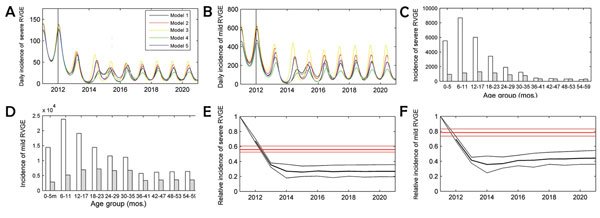Volume 20, Number 1—January 2014
Research
Dynamic Modeling of Cost-effectiveness of Rotavirus Vaccination, Kazakhstan
Figure 1

Figure 1. . Projected epidemiologic effect of rotavirus vaccination in children <5 years of age in Kazakhstan. A) Estimated daily incidence of severe RVGE (base case scenario) with introduction of rotavirus vaccination in January 2012 in the 5 candidate models. B) Estimated daily incidence of mild RVGE (base case) with introduction of the rotavirus vaccination in January 2012 in the 5 candidate models. C) Yearly age-specific incidence of severe RVGE pre-vaccination (white) and 10 years postvaccination (gray). D) Yearly age-specific incidence of mild RVGE pre-vaccination (white) and 10 years postvaccination (gray). E) Relative incidence of severe RVGE with vaccination compared with the expected incidence without vaccination; the blue curve shows the mean relative incidence with lower and upper bounds predicted by the synthesis of dynamic models, including both direct and indirect effects, while the red curve shows the relative incidence predicted by a static cohort model incorporating only the direct effects (Technical Appendix). F) Relative incidence of mild RVGE with vaccination compared with the expected incidence without vaccination; the blue curve shows the mean relative incidence with lower and upper bounds in the synthesis of dynamic models; the red curve shows the relative incidence predicted by a static cohort model.